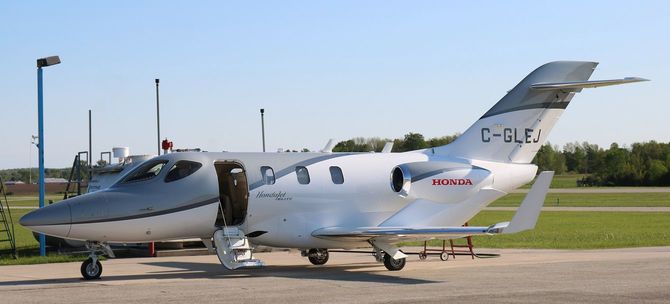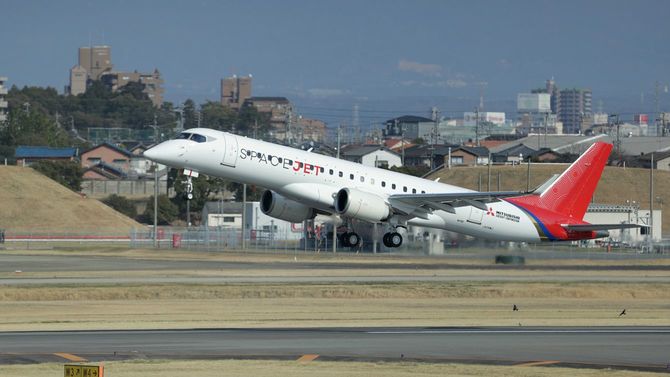https://president.jp/articles/-/48499?page=1
シェアしました。
「官民のもたれあい」で事態は混迷
6度の延期を繰り返し、2020年に事実上の開発凍結に
7月1日付の日刊工業新聞に三菱航空機の決算公告がひっそり載った。そこに記された2021年3月期の債務超過額は5559億円。国産初のジェット機「スペースジェット」(2019年にMRJから名称変更)の開発を実質的に凍結したが、前期の4646億円から900億円超も膨らんだ。今年3月には資本金を1350億円から5億円に減らし、累積損失の一部を穴埋めしたが、バランスシートはなかなか改善しない。
「日の丸ジェット」は日本の産業界の夢を背負っていた。日本の産業構造は「自動車一本足」といわれる。自動車1台あたりの部品点数は2万から3万点。一方、ジェット機は100万点ともいわれる。「日の丸ジェット」商用化は、雇用や経済・産業への波及効果が大きく、日本の産業構造を刷新すると期待されていた。
しかし、6度の延期を繰り返し、2020年に事実上の開発凍結に追い込まれた。親会社である三菱重工業は、この間、いくつもの失態を犯している。そのひとつが「経営サイドの混迷」だ。
同じ国産の「ホンダジェット」はリーダーが不変
三菱航空機の社長はこれまでに6人。2008年に初代社長となる三菱重工の戸田信雄執行役員が就任して以来、20年までにたびたび交代してきた。そこに込められた狙いは、こんなふうに説明されてきた。
「プライドが高く縄張り意識が強いといわれる名古屋航空宇宙システム製作所の閉鎖的な体質を打破する」「火力発電プラント出身という門外漢だが、本社のにらみが利く体制にする」「ライバルのカナダ・ボンバルディア出身の技術者を招いて、遅れを取り戻す」……。
しかし、そうした狙いは裏目に出続けた。結局、トップが変わる度に現場が混乱することになったのだ。同じ国産の「ホンダジェット」はさまざまな困難を抱えながらも藤野道格氏が30年もの間、トップに君臨。日本勢として初めてプライベートジェットの市場を開拓していった。機体の大きさが違うため単純比較はできないが、あまりにも対照的だ。
「官民のもたれあい」で事態は混迷
失敗の原因となった「根拠のない楽観」
また、「根拠のない楽観」というのも、失敗の原因となった。
たとえば「型式証明」だ。安全性が問われる航空機の商用飛行の資格を得るには100万点ともいわれる部品のすべてに耐空性を証明しないといけない。型式証明の審査・承認は原産国の航空当局が担うが、YS-11以降、民間旅客機の開発を日本は手掛けていなかったこともあり、「管轄する国土交通省に知見のあるスタッフは片手にも満たなかった」(三菱重工)という。
国交省でもスペースジェットの型式証明のために検査官が大幅に増員され、ボンバルディアや米ボーイングから型式認証の経験者を招いて対応に回った。その背景には、スペースジェットには同じサイズのボンバルディアやエンブラエルなどに納入される海外製の部品が多く採用されていたため、「海外から購入した部品に少し手を入れれば型式証明は取得できる」という認識があったようだ。しかしそれは甘かった。三菱重工はスペースジェットの仕様にあわせたデータをイチからとり、開発しなおさなければならなかった。
戦闘機は防衛省が責任を負う構造になっているが…
型式証明を審査する国のスタッフもいなければ、ノウハウもない中で、国交省や三菱重工は審査にかかる時間を節約するために、アメリカ当局のサポートを仰いだ。日本の航空当局の審査で過不足がないかアメリカ当局にチェックしてもらったり、部品の規格や品質など一つひとつの事案を米当局に確認してもらったりしながら作業する手間のかかるやり方に頼るしかなかった。
国が60%を出資して開発したYS-11とは違い、スペースジェットの開発主体はあくまで三菱重工という民間の1社だ。YS-11が頓挫した後、三菱重工は川崎重工やスバルなどとともにボーイングなどの下請け(サプライヤー)として、航空機開発に携わっている。しかし「全機」と「部品」の開発では、担う範囲や規模がまったく違う。
三菱重工は防衛関連の戦闘機開発の実績がある。しかし戦闘機は防衛省が開発予算や安全性・機能性を含めた仕様や審査などを行い、責任も負う。一方、旅客機の場合は、すべての責任を民間メーカーが負う。構造もまったく違うのだ。
「官民のもたれあい」で事態は混迷
「スコープクローズ」と呼ばれる米国での規制
政府の判断の甘さも、失敗の原因となった。日本の「自動車依存」を変えるという国家レベルの目標があったにもかかわらず、1社の民間企業に膨大な投資が必要となる民間旅客機開発を担わせてしまった。
米国ではダグラス社がボーイングに吸収されたほか、ロッキードも民間機から早々に撤退。欧州でも英BACや仏シュド・アビアシオンなどが共同で「コンコルド」の開発を手掛けたが、騒音や低い採算性、死傷事故もあり2003年に運航を開始してから30年ももたずに製造が打ち切られるなど、民間航空機開発は非常に難しいプロジェクトだ。
リスクに対する見通しの甘さはほかにもある。その最たる例が「スコープクローズ」と呼ばれる米国での規制を巡る問題だ。
5000億円もの債務超過を生んだ、あまりに楽観的な見通し
スコープクローズとは米国の航空会社とパイロットとの間の労使協定で、地方路線で飛ばせる機体サイズを制限する取り決めだ。スペースジェットのような小型機を運航する格安航空会社(LCC)などが無制限に旅客機を飛ばすと、大手航空会社のパイロットの仕事が奪われるため、座席数を76席以下に抑えるというものだ。
当初、スペースジェットが開発していたのは座席数90席の「M90」。仮に型式証明が取れても、最大の需要地である米国では飛ばせない。国交省も三菱重工もスコープクローズの存在は知っていたが、「緩和される方向だ」との予測を立てていた。しかし、一向に緩和されることはなく、設計変更に追い込まれた。
初めて尽くしの型式証明、スコープクローズに対する認識の甘さなど、開発にあたって、三菱重工も監督する国交省もあまりにも楽観的でずさんな見通しの下で、開発に踏み切ったことが三菱航空機に5000億円もの債務超過を残す失態を生んだ。
国産ジェットの開発をどう再構築していくか
日本がもたつく間に、ロシアはスホイ・スーパージェット、中国はCOMAC・ARJ21でリージョナルジェットの量産に成功している。
三菱重工はM-90に代わり、座席数65~88席の「M-100」の開発を検討している。三菱航空機は引き続き型式認証の作業を進めるとしているが、リストラで設計作業のペースがスローダウンするのにもかかわらず、国交省がこれまでと同じ規模でスタッフを抱え続けることは難しい。三菱重工も脱炭素の流れの中で、主力の火力発電所向けのタービンの受注も見込みづらく、稼ぎ頭不在のなかでスペースジェットの開発費を捻出するのも厳しくなっている。
半導体や液晶など、経済産業省が主導する形で再編してきたが、今や半導体ではルネサスエレクトロニクスが、液晶もジャパンディスプレイがほそぼそと事業を続けている。東芝も株主の投資家からの突き上げをかわすために経産省に頼るなど、「もたれあい」の構図が露呈した。
国産ジェットの開発をどう再構築していくか、官民ともに抜本的に見直す必要がある。
ーーー
https://president.jp/articles/-/48499?page=1 I
shared it.
The situation is confused by "public-private leaning"
Repeated postponement 6 times, de facto development freeze in 2020
The announcement of Mitsubishi Aircraft's financial results was quietly published in the Nikkan Kogyo Shimbun dated July 1. The amount of insolvency for the fiscal year ended March 2021 stated there was 555.9 billion yen. The development of the first domestically produced jet "SpaceJet" (renamed from MRJ in 2019) was virtually frozen, but it increased by more than 90 billion yen from 464.6 billion yen in the previous term. In March of this year, the capital was reduced from 135 billion yen to 500 million yen to make up for a part of the cumulative loss, but the balance sheet has not improved easily.
"Hinomaru Jet" carried the dream of Japanese industry. The industrial structure of Japan is said to be "one-legged automobile". The number of parts per car is 20,000 to 30,000. On the other hand, it is said that there are 1 million jet planes. The commercialization of the "Hinomaru Jet" had a large ripple effect on employment, economy and industry, and was expected to renew the industrial structure of Japan.
However, it was postponed six times and was forced into a de facto freeze on development in 2020. The parent company, Mitsubishi Heavy Industries, has committed a number of blunders during this time. One of them is "confusion on the management side."
The leader of the same domestic "HondaJet" remains unchanged
So far, there are six presidents of Mitsubishi Aircraft. Since the appointment of Nobuo Toda, executive officer of Mitsubishi Heavy Industries, who became the first president in 2008, he has been replaced frequently by 20 years. The aim contained in it has been explained in this way.
"Break through the closed constitution of Nagoya Aerospace Systems Mfg. Co., Ltd., which is said to have high pride and strong territorial consciousness." Invite an engineer to catch up with the delay. "
However, such an aim continued to backfire. In the end, every time the top changed, the scene became confused. The same domestic "HondaJet" has various difficulties, but Michimasa Fujino has reigned at the top for 30 years. It was the first Japanese company to develop a private jet market. It's not possible to make a simple comparison because the size of the aircraft is different, but it's too contrasting.
The situation is confused by "public-private leaning"
"Unfounded optimism" that caused the failure
"Unfounded optimism" was also a cause of failure.
For example, "type certificate". In order to qualify for commercial flight of an aircraft that requires safety, airworthiness must be proved for all of the one million parts. The aviation authorities of the country of origin are responsible for the examination and approval of the type certificate, but since Japan has not been involved in the development of commercial airliners since YS-11, "Staff with knowledge of the Ministry of Land, Infrastructure, Transport and Tourism has one hand. It did not meet the requirements "(Mitsubishi Heavy Industries).
At the Ministry of Land, Infrastructure, Transport and Tourism, the number of inspectors was significantly increased to certify the type of SpaceJet, and people with experience in type approval were invited from Bombardier and Boeing in the United States to respond. Behind this, the SpaceJet used many overseas-made parts delivered to Bombardier and Embraer of the same size, so "you can get a type certificate by slightly modifying the parts purchased from overseas." There seems to have been recognition. But it was sweet. Mitsubishi Heavy Industries had to take data from the beginning and redevelop it according to the specifications of the SpaceJet.
The fighter is structured so that the Ministry of Defense is responsible ...
With no national staff or know-how to review the type certificate, the Ministry of Land, Infrastructure, Transport and Tourism and Mitsubishi Heavy Industries sought the support of the US authorities to save time in the review. There is no choice but to rely on the time-consuming method of working while having the U.S. authorities check whether there is excess or deficiency in the examination of the Japanese aviation authorities, or having the U.S. authorities check each case such as the standard and quality of parts. There wasn't.
Unlike the YS-11, which was developed by the government with a 60% stake, the main developer of the SpaceJet is Mitsubishi Heavy Industries, a private company. After the YS-11 failed, Mitsubishi Heavy Industries, along with Kawasaki Heavy Industries and Subaru, has been involved in aircraft development as a subcontractor (supplier) for Boeing and others. However, the scope and scale of the development of "all machines" and "parts" are completely different.
Mitsubishi Heavy Industries has a track record of developing defense-related fighters. However, the Ministry of Defense is responsible for the development budget, specifications and examinations including safety and functionality of fighter aircraft. On the other hand, in the case of passenger aircraft, the private manufacturer bears all responsibility. The structure is also completely different.
The situation is confused by "public-private leaning"
Regulations in the United States called "Scope Clause"
The lack of judgment of the government also caused the failure. Despite Japan's national goal of changing its "automobile dependency," one private company has been forced to develop a private airliner that requires huge investment.
In the United States, Douglas was absorbed by Boeing, and Lockheed quickly withdrew from civilian aircraft. In Europe, the British BAC and the French Sud Aviation jointly worked on the development of the "Concorde", but due to noise, low profitability, and fatal accidents, it was manufactured less than 30 years after it started operation in 2003. The development of commercial aircraft is a very difficult project.
There are other weak prospects for risk. The prime example is the issue of regulation in the United States called "scope closure."
Too optimistic outlook that has created an insolvency of 500 billion yen
Scope Clause is a labor-management agreement between US airlines and pilots, which limits the size of aircraft that can be flown on local routes. If a low-cost carrier (LCC) that operates small aircraft such as the SpaceJet flies an unlimited number of passenger planes, the jobs of pilots of major airlines will be taken away, so the number of seats will be reduced to 76 or less.
Initially, SpaceJet was developing the "M90," which has 90 seats. Even if the type certificate can be obtained, it cannot be flown in the United States, which is the largest demand area. Both the Ministry of Land, Infrastructure, Transport and Tourism and Mitsubishi Heavy Industries knew the existence of the scope clause, but predicted that it would be "eased." However, it was not alleviated at all and was forced to change the design.
Mitsubishi Aircraft has decided to develop it under the optimistic and sloppy outlook that Mitsubishi Heavy Industries and the Ministry of Land, Infrastructure, Transport and Tourism, which supervises Mitsubishi Heavy Industries, have decided to develop it for the first time, such as type certification and lack of awareness of scope clause. It caused a blunder that left an excess of debt.
How to rebuild the development of domestic jets
Russia has succeeded in mass-producing regional jets with Sukhoi Superjet and China with COMAC ARJ21 while Japan is sluggish.
Mitsubishi Heavy Industries is considering the development of the "M-100" with 65 to 88 seats instead of the M-90. Mitsubishi Aircraft says it will continue to work on type approval, but it will be difficult for the Ministry of Land, Infrastructure, Transport and Tourism to continue to have staff on the same scale as before, despite the slowdown in design work due to restructuring. With the trend of decarbonization, it is difficult for Mitsubishi Heavy Industries to receive orders for turbines for its main thermal power plants, and it is becoming more difficult to raise space jet development costs in the absence of earning heads.
It has been reorganized under the leadership of the Ministry of Economy, Trade and Industry, such as semiconductors and liquid crystals, but now Renesas Electronics is continuing its business in semiconductors and Japan Display is continuing its business in liquid crystals. Toshiba also relied on the Ministry of Economy, Trade and Industry to avoid the push from shareholders' investors, revealing the composition of "lean".
It is necessary for both the public and private sectors to drastically review how to rebuild the development of domestic jets.




0 件のコメント:
コメントを投稿